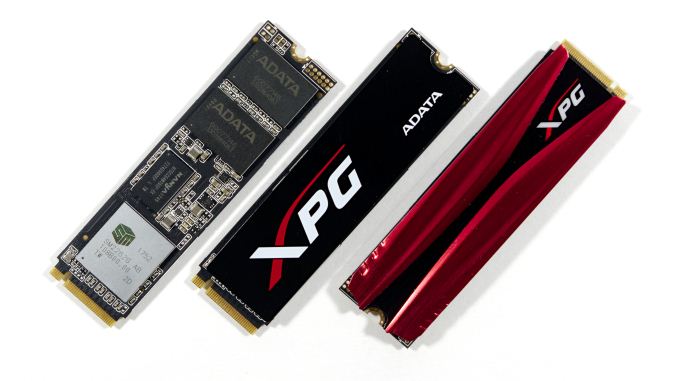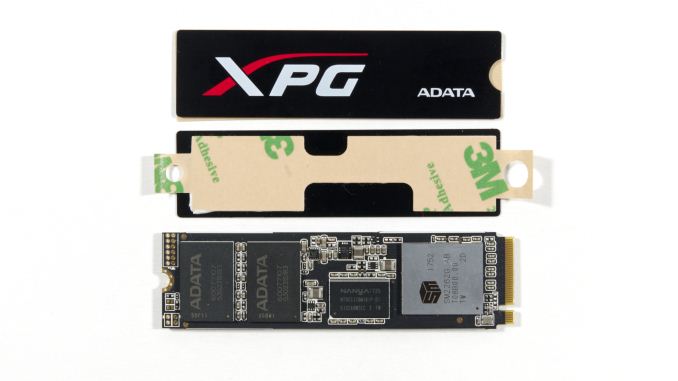The ADATA XPG SX8200 & GAMMIX S11 NVMe SSD Review: High Performance At All Sizes
by Billy Tallis on July 25, 2018 11:00 AM EST
ADATA has a very broad portfolio of consumer NVMe SSDs, featuring most of the controller solutions available on the open market. Not all of these have been particularly successful, but the most recently released drives use a formula that has been working well for several other players in the SSD market: Silicon Motion's SM2262 controller combined with Intel/Micron 64-layer 3D TLC NAND flash memory. The ADATA XPG SX8200 and GAMMIX S11 SSDs differ primarily in branding and the design of their heatspreaders, but underneath they both feature the same SSD architecture that we've found makes for a great combination of high performance and reasonable prices.
The SX8200 and GAMMIX S11 replace several older ADATA SSDs that used Silicon Motion's first NVMe SSD controller, the SM2260. The XPG SX8000 paired that controller with Micron's 32-layer 3D MLC NAND, while the XPG SX7000 and GAMMIX S10 used Micron's 32-layer 3D TLC NAND. Those first-generation NVMe drives from ADATA suffered from the limitations of the SM2260 controller and the first-generation 3D NAND from Intel and Micron. As a result, even the use of MLC NAND in the SX8000 couldn't enable it to reach the performance of good TLC-based SSDs like the Samsung 960 EVO. The SX7000 and GAMMIX S10 were even worse off and despite ADATA's branding (and pricing) them like high-end SSDs, they were among the slowest NVMe SSDs on the market and could not reliably outperform mainstream SATA SSDs.
| ADATA Consumer NVMe SSD Comparison | |||
| Model | XPG SX8200, XPG GAMMIX S11 |
XPG SX8000 | XPG SX7000, XPG GAMMIX S10 |
| Capacities | 240–960GB | 128GB–1TB | 128GB–1TB |
| Controller | Silicon Motion SM2262 | Silicon Motion SM2260 | |
| NAND Flash | Micron 64L 3D TLC | Micron 32L 3D MLC | Micron 32L 3D TLC |
| Form-Factor | double-sided M.2-2280, PCIe 3.0 x4 | ||
| Protocol | NVMe 1.3 | NVMe 1.2 | |
| Sequential Read | 3150–3200 MB/s | 1000–2400 MB/s | 660-1750 MB/s |
| Sequential Write | 1100–1700 MB/s | 300–1000 MB/s | 450-860 MB/s |
| Random Read | 200k–310k IOPS | 45k-100k IOPS | 35k-130k IOPS |
| Random Write | 240k–280k IOPS | 75k-140k IOPS | 95k-140k IOPS |
| Warranty | 5 years | ||
| Write Endurance | 0.37 DWPD | 0.34 DWPD | 0.34 DWPD |
| Announced | March 2018 (SX8200) April 2018 (S11) |
September 2016 | April 2017 (SX7000) July 2017 (S10) |
ADATA has also released or announced several other consumer NVMe SSDs that aren't included in the chart above. The SX6000 and SX7100 use Realtek controllers and the SX9000 uses a Marvell controller. The Silicon Motion-based drives occupy the middle of the lineup and are the most popular and widely available NVMe drives from ADATA.
This year, most of the SSD industry is working with 64-layer 3D NAND (almost exclusively TLC NAND), and there's no clear winner or loser in raw NAND performance this time around. Silicon Motion's second-generation NVMe controllers are capable of delivering far higher performance than the disappointing SM2260, and the market for high-end SSDs is no longer dominated exclusively by Samsung.
Intel was first to market with the SM2262 controller in the 760p SSD, which features some Intel-specific customizations to the Silicon Motion reference design. The ADATA XPG SX8200 and GAMMIX S11 are much closer to the reference design, but use NAND that has been binned and packaged by ADATA, and come with ADATA's own heatspreader designs. The other SM2262 drive we've reviewed is the 1TB HP EX920. Compared to the EX920, the ADATA drives have lower usable capacities due to reserving more spare area, which usually improves sustained write performance. Today's review focuses on 240GB and 480GB models from ADATA, which gives us a chance to see what performance is like at the more affordable end of the product line. We can also compare the performance of the SX8200 with no heatspreader against the GAMMIX S11 with a heatspreader (and with slightly newer firmware). Spoiler: those differences never matter to real-world usage. For all practical purposes, the SX8200 and GAMMIX S11 are just cosmetically different.
| ADATA XPG SX8200 and GAMMIX S11 Specifications | |||||
| Capacity | 240 GB | 480 GB | 960 GB | ||
| Controller | Silicon Motion SM2262 | ||||
| NAND Flash | Micron 64L 3D TLC | ||||
| Form-Factor, Interface | M.2-2280, PCIe 3.0 x4, NVMe 1.3 | ||||
| Sequential Read | 3200 MB/s | 3200 MB/s | 3150 MB/s | ||
| Sequential Write | 1100 MB/s | 1700 MB/s | 1700 MB/s | ||
| Random Read IOPS | 200K IOPS | 310K IOPS | 310k IOPS | ||
| Random Write IOPS | 240K IOPS | 280K IOPS | 280k IOPS | ||
| Warranty | 5 years | ||||
| Write Endurance | 160 TB 0.37 DWPD |
320 TB 0.37 DWPD |
640 TB 0.37 DWPD |
||
| Current Retail Price |
SX8200 | $91.93 (38¢/GB) | $139.99 (29¢/GB) | $284.99 (30¢/GB) | |
| S11 | $84.99 (35¢/GB) | $159.99 (33¢/GB) | $299.99 (31¢/GB) | ||
ADATA's performance specifications for the SX8200 and GAMMIX S11 show that the 240GB models are significantly handicapped for all access patterns other than sequential reads. Even so, that smallest SX8200 is rated to easily outperform the largest and fastest model from the preceding SX8000 family. With the move to higher-density 3D NAND, ADATA has dropped the 128GB capacities from the lineup. Performance at that capacity would be even lower than what the 240GB models provide, and would no longer be reasonable for a high-end NVMe SSD. ADATA's low-end SX7100 series is planned to retain a 120GB option. ADATA has not yet brought a 2TB M.2 NVMe SSD to market, but they are prepared to extend the SX8200 family to a 1.92TB (usable capacity) model.
Write endurance for the SX8200 and GAMMIX S11 is rated for a little over the typical 0.3 drive writes per day, and the five year warranty period is standard for high-end SSDs. The PCB used by the SX8200 and GAMMIX S11 has components on both sides at all capacities, so even without the heatspreaders these drives won't fit into every notebook computer.
The ADATA XPG GAMMIX S11 comes with the same two-tone textured heatspreader that was used on the GAMMIX S10. The thermal pads anchor the red parts of the heatspreader to the chips below while the black recessed area does not make contact with the drive. The ADATA XPG SX8200 comes with a flat black heatspreader ready to be installed and a thermal pad that makes full contact with the controller, DRAM and NAND packages on the top side of the drive. For this review, the SX8200s were tested without the heatspreaders installed.
In addition to comparing the SX8200 and GAMMIX S11 against their immediate predecessors from ADATA, this review compares them against the following competitors:
- The 1TB HP EX920, as an example of a higher-capacity SSD with essentially the same internals
- An assortment of Samsung NVMe SSDs that generally represent the gold standard for high-performance high-price SSDs.
- The Intel Optane SSD 900P and 800P, the most expensive consumer SSDs, with absolutely unbeatable performance in some areas, but not the fastest in every category.
- The Intel SSD 760p, very similar to the SX8200 or HP EX920 save for some customizations that Intel hasn't detailed.
- The second-generation Western Digital WD Black, a top of the line TLC-based SSD with a new in-house controller that poses the most direct threat Samsung's 9x0 EVO SSDs have faced so far.
| AnandTech 2018 Consumer SSD Testbed | |
| CPU | Intel Xeon E3 1240 v5 |
| Motherboard | ASRock Fatal1ty E3V5 Performance Gaming/OC |
| Chipset | Intel C232 |
| Memory | 4x 8GB G.SKILL Ripjaws DDR4-2400 CL15 |
| Graphics | AMD Radeon HD 5450, 1920x1200@60Hz |
| Software | Windows 10 x64, version 1709 |
| Linux kernel version 4.14, fio version 3.6 | |
| Spectre/Meltdown microcode and OS patches current as of May 2018 | |
- Thanks to Intel for the Xeon E3 1240 v5 CPU
- Thanks to ASRock for the E3V5 Performance Gaming/OC
- Thanks to G.SKILL for the Ripjaws DDR4-2400 RAM
- Thanks to Corsair for the RM750 power supply, Carbide 200R case, and Hydro H60 CPU cooler
- Thanks to Quarch for the XLC Programmable Power Module and accessories
- Thanks to StarTech for providing a RK2236BKF 22U rack cabinet.
















19 Comments
View All Comments
stanleyipkiss - Wednesday, July 25, 2018 - link
I.... I... I want one!superunknown98 - Wednesday, July 25, 2018 - link
Yeah, what is the deal with the Intel 760p? is there a firmware that fixes it?Billy Tallis - Wednesday, July 25, 2018 - link
There hasn't been a firmware update for the 760p yet: https://www.intel.com/content/www/us/en/support/ar...Rick F - Wednesday, July 25, 2018 - link
Thank you. This helped me avoid two different mistakes buying an M.2 for an Asrock x370 Taichi, All of the nonworking Adata's are on the QVL, along with the 8200 that works.The 8200 read speed is comparable to Samsung, but the write speed is about half as fast as Samsung. For the cost the 8200 is much more affordable for PCIe 3.0 nvme 1.3.
So now what to do...a few years ago, B+M M.2 Sata was pretty standard. PCIe was Samsung only and cost too much. Now M.2 is in transition and not so easy.
Think I'll sleep on it, and choose a lot of Sata space, or M.2 with a controller that hasn't gone through the wear leveling of an ssd yet...Again thanks for the heads up.
CheapSushi - Wednesday, July 25, 2018 - link
This just makes me want the Intel 900P even more. I'm hoping to have Optane drives for performance, cache and main programs & OS and just use QLC NAND drives for storage.Amandtec - Thursday, July 26, 2018 - link
How about run Fuzedrive with 2GB ramdrive, 32GB Optane, 256QLC and 4+TB HDD. Everything should kind of work out quite nicely (unless you mostly access very large files only once).deil - Thursday, July 26, 2018 - link
that's my plan, I just want to use 58 GB optane drive, and maybe 512GB mv500 SSD.Death666Angel - Thursday, July 26, 2018 - link
I guess some people, including me, want to KISS regarding their PC storage tiers. How are the failure states when it comes to the Fuzedrive implementation? Is it all just cached on the faster stuff and backed up on the normal HDD, so a drive failure "in front" isn't catastrophic? I'm personally super fine with my M.2 NVME SSD (960 Evo on sale) as an OS drive and a spinning platter for other stuff on my main PC (soon to be replaced with a M.2 SATA / NVME SSD depending on motherboard upgrades) and a whole bunch of HDDs in my file server. I don't see a scenario where I need optane like performance just yet. And for the Fuzedrive thing, see above, plus I don't need simple documents or pictures loading faster, they load just fine for my taste. :) Avoids all the potential headaches of another layer of software between me an my data.DigitalFreak - Thursday, July 26, 2018 - link
With FuzeDrive, if either drive fails, you lose all data. Similar to RAID 0.Samus - Friday, July 27, 2018 - link
Backblaze is $50 a year.